The little-known book that shaped the minds of Steve Kerr and Pete Carroll

Get all of Chris Ballard's columns as soon as they’re published. Download the new Sports Illustrated app (iOS or Android) and personalize your experience by following your favorite teams and SI writers.
The book’s not much to look at.
Roughly the size of a Reader’s Digest. Only 134 pages long. You’ve likely never heard of the author, Timothy Gallwey, even though the title’s been in print for 40-plus years. The opening quote is from Maharaji; the back cover promises the ability to “Master Your Game from the Inside Out!”
And yet this is it, the book Warriors coach Steve Kerr swears by, the one he re-reads every off-season. It’s a book he distributes frequently (“I have like 10 copies because I’m always giving them out,” he says); one he says informed both his playing career and his coaching approach; a book that bonded him with Seahawks coach Pete Carroll and provides an unexpected link to his current opponent, the Oklahoma City Thunder; a book some view as akin to a cheat code not just for athletics, but life.
A book about tennis.
"It does not mean not to think—but to be the one who directs your own thinking." (page 131)
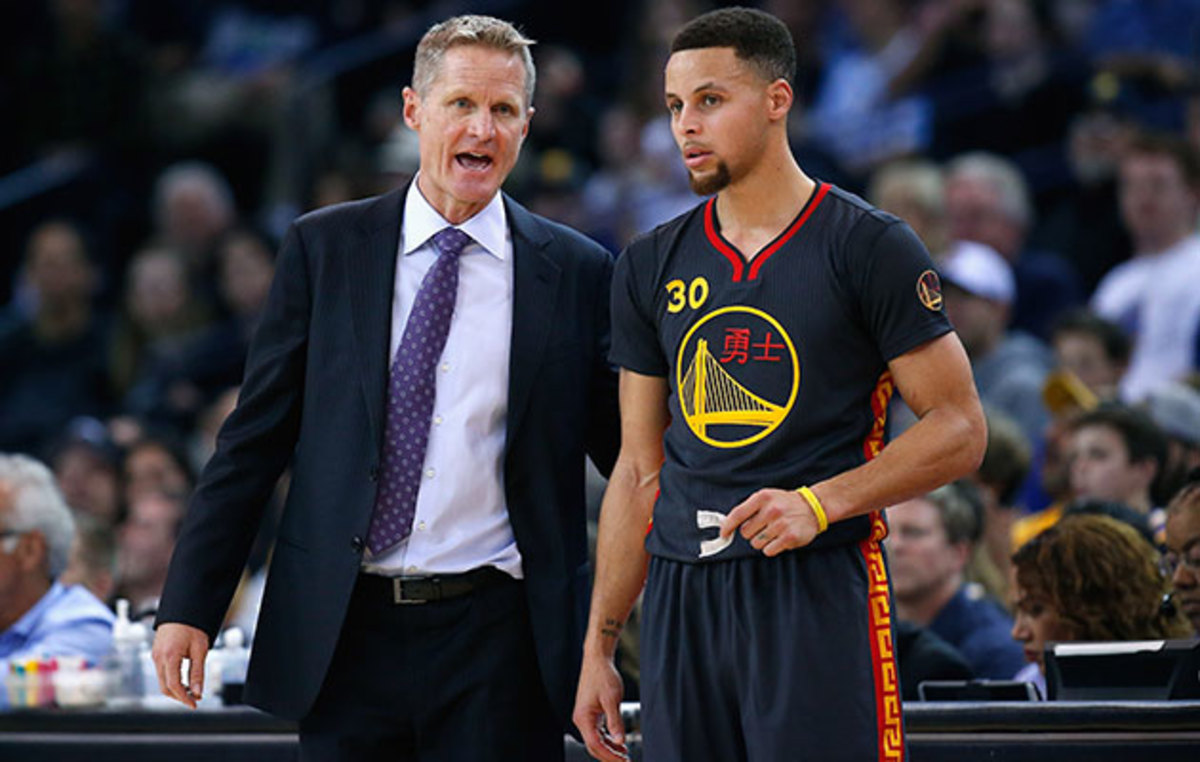
Full disclosure: This story was supposed to be about fiction. Novels, mainly. Kerr reads them during the season, exchanging recommendations with other Warriors staffers. It’s a departure from our stereotype of the obsessed coach, crashing on an office couch after late-night film sessions, permanently moored on the low end of the work-life teeter-totter.
A few weeks ago I sat down with Kerr at the Warriors practice facility in Oakland to talk about what he reads (“The Amazing Adventures of Kavalier & Klay”, “The Goldfinch”, “All the Light We Cannot See”, anything by Pat Conroy), his preferences (“actual books”, not Kindle; WWII era stories), and habits (first thing in the morning; last thing at night). Soon enough, however, Kerr steered the conversation in a different direction. The book he really wanted to discuss was nonfiction, and somewhat obscure. “Have you ever heard of the Inner Game of Tennis?” he asked.
It’s about the challenge athletes face in making the connection between the mind and body, Kerr explained, becoming enthused. He said he first read it as a player with the Bulls. At the time his role was to enter the game in short spurts, take a few jumpers and then sit back down. Make the shots and the night was a success. Miss and it was a failure. The stress, as you can imagine, was formidable.
• MORE NBA: Four reasons the Warriors are on the brink of collapse
Chip Engelland, one of Kerr’s mentors, recognized this and recommended he read “Inner Game.” Engelland had coached Kerr during summer leagues—both went to Pacific Palisades High School in Los Angeles—and discovered the book near the end of his own playing career, picking it up after returning from overseas, in hopes of improving his tennis game. Immediately, Engelland saw the practical application for hoops, and he employed the book’s “nonjudgment practices”—more on those later—while playing for the San Jose Jammers of the CBA. “I was working it pretty good,” says Engelland, now a Spurs assistant and the man responsible for remaking the shots of Grant Hill, Tony Parker and Kawhi Leonard. “For me, it clicked.”
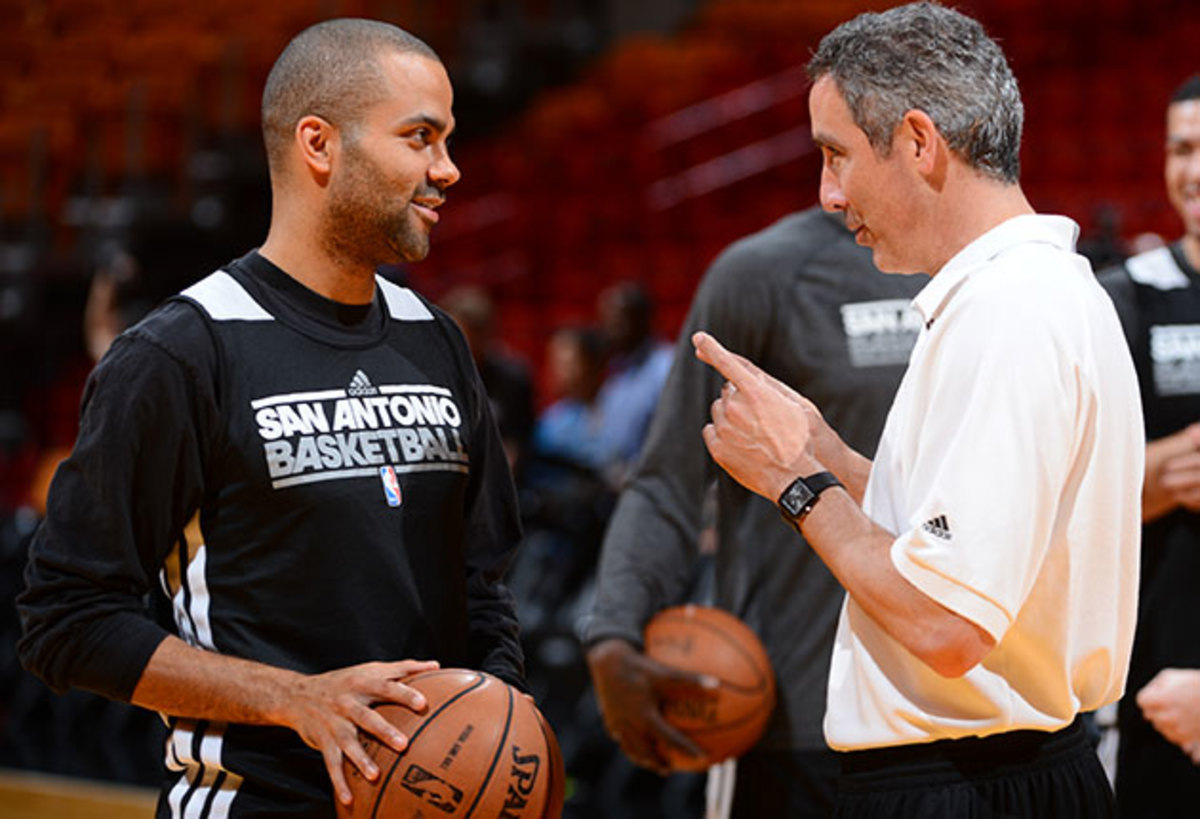
Now, Engelland gave it to Kerr. Many players receive books from coaches and toss them in the back of their locker. Others flip through them, dutifully. Kerr read “Inner Game”, then read it again, taking notes. He was hooked.
The book’s basic concept, which draws on Zen Buddhist principles, is simple: Our brains often screw up what our bodies are perfectly capable of doing on their own (or, “potential minus interference equals performance,” in Gallwey’s terms). “If you ever watch a tennis player, a lot of them will talk to themselves. ‘Oh, what are you doing!?’” explains Kerr. “[Gallwey] was a tennis teacher and he was watching his student one day and thought to himself, ‘Who is he talking to?’ It’s kind of weird if you actually stop and think about it. You’re talking to yourself, right? So does that mean there are two yous?”
According to Gallwey, there are. One is your mind (“Self One”) and the other your body (“Self Two”). And far too often in sports, Self One is berating Self Two. We’re constantly disappointed in ourselves (“My backhand sucks today! Hit a goddamn shot!”). Here we have a remarkable physical machine, one capable of innately calculating and executing complicated sequences in microseconds, and we treat it with contempt. The question for the athlete, as Kerr puts it: “How do you get out of your own way? How do you stop the chatter in your mind?”
Kerr followed Gallwey’s advice, endeavoring to stop judging his play and instead quiet his thoughts—what many know as mindfulness. Forget what happened on the last two plays, what will happen if you miss this shot, and your weekend plans. Instead, concentrate on the seams of the ball, or the whack-thump of hit and bounce (in tennis), or the pattern of your breathing. Occupy your brain and it can’t fret or chide (Keep your wrist firm, move your front foot, grip tight!).
• MORE NBA: Thunder Road: How long until Durant and OKC reign?
It’s similar to how NBA players employ free–throw routines, whispering mantras (like Karl Malone), repeating elaborate sequences (Jason Kidd), or humming the Counting Crows (like Dirk Nowitzki once did), all in the service of distracting themselves from themselves. (Tom Amberry, the man who set a Guinness record of 2,750 consecutive free throws made, at age 71, didn’t even look up at the rim until the last moment). Now apply that concept to the entire game. For some athletes, this is natural. “Steph [Curry] is great about that,” says Kerr. “I don’t think Steph comes off the floor and says, ‘What are you doing?!” Similarly, to watch Klay Thompson shoot—without hesitation, often disregarding past results and game situation—is to witness a man at one with his body.
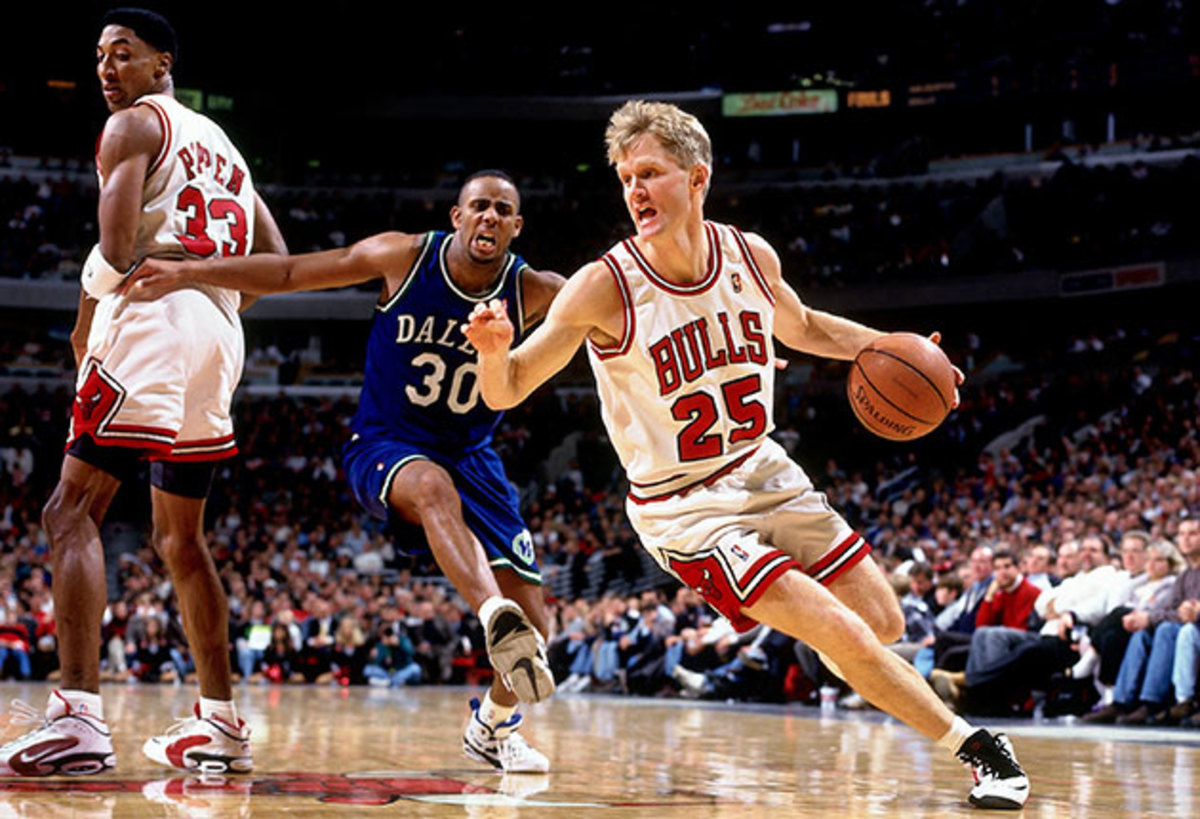
Not so for the overthinkers like Kerr – those with a “high care factor,” in Engelland’s parlance. Engelland traces Kerr’s mindset back to high school and college when he was, “almost a mistake-free player.” One turnover or missed shot vexed him. (Engelland says Grant Hill is similar, and he later gave the book to Hill, who consulted it regularly). To get out of his own head, Kerr tried Gallwey tricks such as pretending to be a different player for a day, thus allowing him to play with more freedom. Kerr chose Jeff Hornacek, the crafty Utah shooting guard (and now head coach of the Knicks). “I loved his game because he had all those flip shots. I didn’t have a lot of that,” says Kerr. “I realized, watching Jeff, I could be more loose and more aggressive and shoot some different shots, not just be a spot up shooter. And one of the ways I got to that was to show up to practice and go, ‘F--k Steve Kerr, I’m going to be Jeff Hornacek!’”
Kerr laughs, remembering it. “And it was way more fun. It’s the same concept as if you’re ever on the scout team. I was always the shooter on the scout team and it was the greatest feeling of freedom because I had to be whoever—Hersey Hawkins. We gotta guard this guy, he’s going to light it up…Well, I’m the guy! And I’d totally get out of my own way. But then I’d stop and think, ‘How pathetic is that? Why don’t I act like that all the time?’”
"Habits are statements about the past, and the past is gone." (page 74)
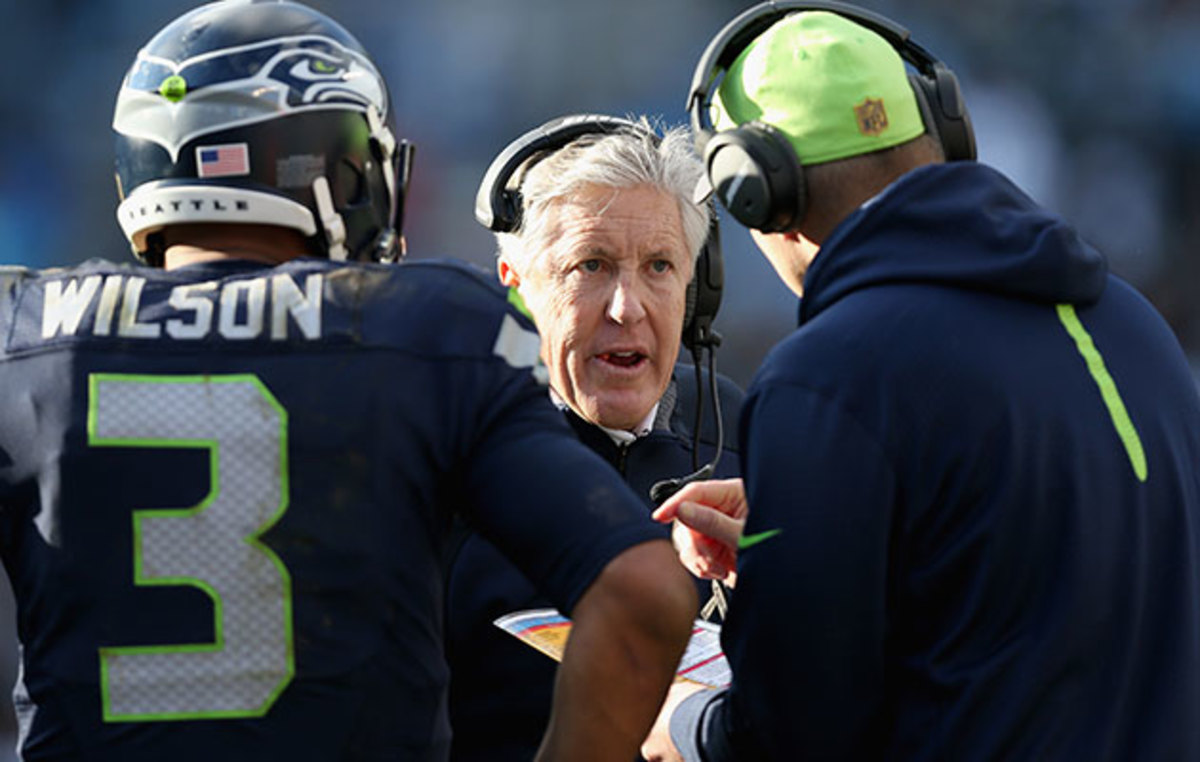
Around the same time that Kerr was discovering the "Inner Game", an energetic football coach from northern California named Pete Carroll was climbing the NFL ladder, first in New York and then San Francisco. An overachieving athlete himself, Carroll first read the "Inner Game” in his first coaching job, as a grad assistant at University of Pacific in the 1970s (that’s also when he began reading the work of psychologist Abraham Maslow).
The book’s message resonated with Carroll, who met Gallwey and kept in touch with him in the years that followed. When Carroll got the USC job, in 2001, he turned to the book—and one of Gallwey’s mentees, Sean Brawley—to help craft his program. Today, he says the "Inner Game" underlies all his coaching principles. “I wish more people understood about it,” says Carroll by phone, after a recent practice. “Mindfulness has always been there in sports. It’s just people understanding how to communicate the principles.”
Gallwey was always an unlikely guru. The captain of the tennis team and an English lit major at Harvard, he was teaching tennis while preparing for life as an academic when he stumbled upon a coaching epiphany: he wasn’t as important as he believed. Specifically, he noticed that if he stopped telling players what to do and instead demonstrated a move and told them to mimic it, without verbal instruction, the coaching was more effective. It was no different than how children learn. Babies crawl until, one day, they walk. A nine-year-old will watch a new dance move at a party for hours, mimic it and, by the end of the night, master it, without any formal “instruction.” Compare this to the regimented, 1-2-3-4, do-this-do-that approach to classic ballroom dance instruction.
• MORE NBA: Giant Killer: Draymond Green dares you to define him
When “Inner Game” came out, in 1972, it was aimed at tennis fanatics. Sales expectations were conservative. It’s now sold over a million copies, spawned six more “Inner Game” books—covering skiing, golf, winning, music, work, and stress—and, as of this writing, was the top instructional tennis book on Amazon. Gallwey makes a living traveling the world speaking to corporations like IBM and Anheuser-Busch. To conduct a Nexis search on him is to encounter a staggeringly wide application of "Inner Game" principles: up pop research papers in, among others, Medical Problems of Performing Artists, American Music Teacher, British Journal of Administrative Management, and Canadian Journal of Human Sexuality. Even something called Quick Printing magazine, which as you might surmise is for people who run printing shops, wrote about the “The Inner Game of Printing.”
Not everyone bought in, of course. A 1978 Washington Post review of one spin-off, “Inner Skiing” called it, “an excellent example of American pop-psychology schlock in the post-guru era,” while noting, “An objective review of the book is almost impossible, because it's entirely subjective and ephemeral.”
Still, Al Gore gave it to aides during his 1984 Senate race, hoping to improve their focus. Itzhak Perlman is reportedly a fan. Unsurprisingly, Phil Jackson’s on board (and in turn helped shape Kerr’s perspective on mindfulness). Billie Jean King referred to it as her “tennis bible.” Paul Westhead listed it as one of his two favorite books, with “Catch-22”. A 1983 New York Times story called the book, “the first to introduce the importance of mental training to the public,” noting that 10 years later sports psychology had become mainstream (at the time, Bill Buckner was seeing a hypnotist; and this before his infamous miscue).
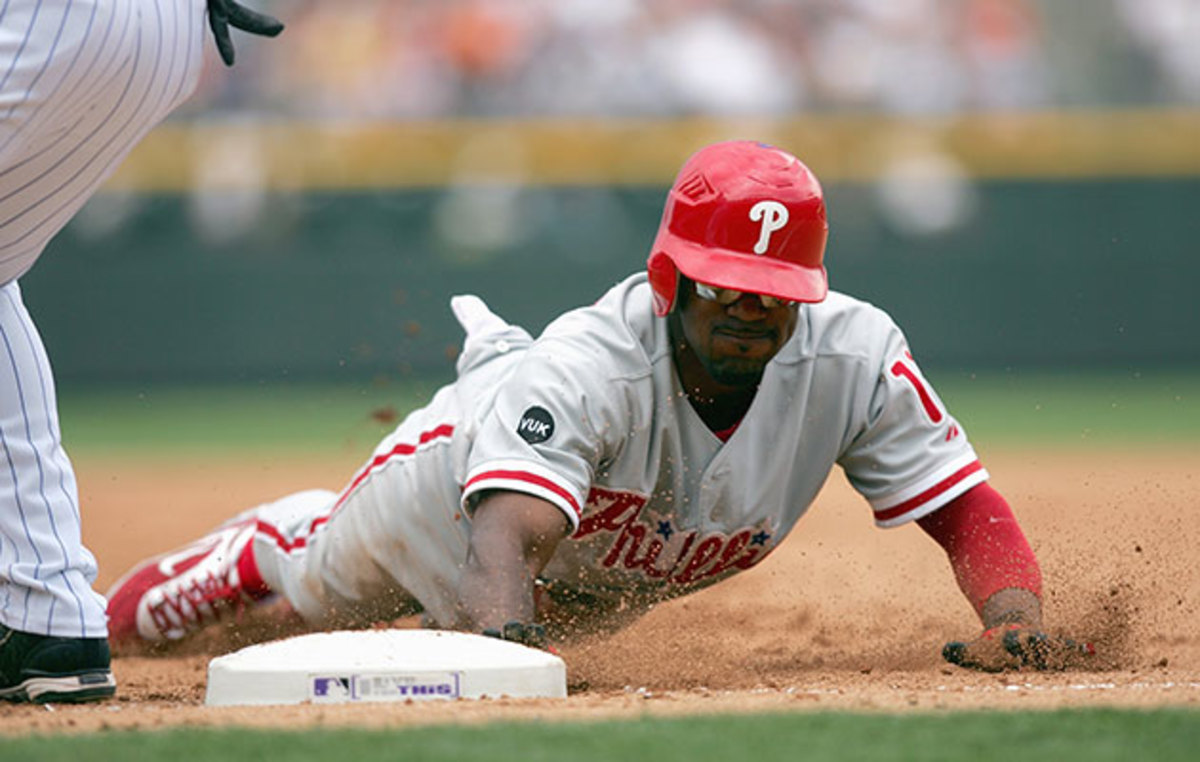
More recently, Phillies shortstop Jimmy Rollins credits “Inner Game” for spurring him to his 2007 NL MVP season, after his girlfriend ordered him the book. "It gets me out of my way," Rollins told the Philadelphia Daily News in 2008. "It is like therapy, almost. It simplified me." Seahawks defensive end Lawrence Jackson, who received the book from Carroll, went so far as to tell writer Reeves Wiedeman, in an excellent feature story: “I don’t want to compare it to the great works of the Bible. But it’s been extremely important.” Jackson was particularly struck by the analogy of a cat waiting to leap at a bird: the cat doesn’t think about it, it acts purely on instinct. As Jackson told SI: “There’s a deeper dynamic there.”
To read the book today is to note vestiges of a different era, including nods to the stigma of groovy West Coast self-improvement (Gallwey argues that the book is not about self-improvement but rather realizing potential already present). A later chapter discusses whether competition is healthy. Does it encourage negative traits? Should we all move to yoga or surfing? Should we even be competitive?
• MORE NBA: Guarding Steph: The only man who can lock down Curry
Acolytes of the book focus on the broader messages, not the specifics. Engelland no longer gives the book to players, preferring to pluck analogies and specific lessons (“It’s a different era now,” he explains, noting that “The Way of Baseball: Finding Stillness at 95 mph”, a book by former MLBer Shawn Green, translates better with modern players). For the right athlete, one who comes in for a conversation, Carroll says he might drop “Inner Game” in their locker. Other times he passes along a chapter or a passage. He long ago stopped using the actual language of the book in practice. “I don’t talk about it with the team,” Carroll says. “We don’t tell them about it, we just do it. We incorporate it into everything we do.”
"The focused mind only picks up on those aspects of a situation that are needed to accomplish the task at hand. It is not distracted by other thoughts or external events." (page 84)
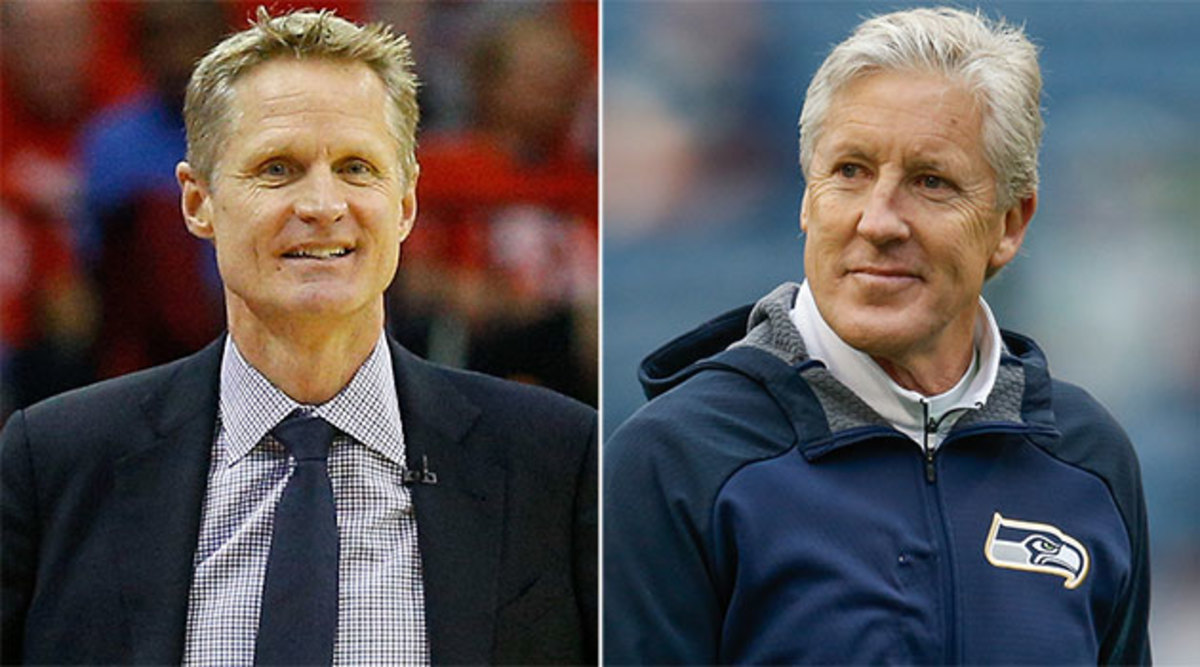
When two "Inner Game" devotees meet, the connection can be immediate and powerful, like finding a long-lost friend you didn’t know you had. This is what occurred in August 2014, when Kerr visited Carroll in Seattle in hopes of gleaning coaching wisdom. Both are California guys at heart, more laid-back than disciplinarian. Both had been giving out the book for years; Carroll to Matt Leinart, Reggie Bush and others, and Kerr to teammates and friends. Still, neither had any idea the other was a fan. “'The Inner Game of Tennis' was just about the first thing we talked about,” says Kerr. And that was that. Says Carroll: “You don’t meet that many guys that are that tuned into it. It’s fun to find one.”
Over the course of two days, Kerr sat in on coaching meetings, watched practice, and lost in a friendly hoops shootout in the meeting room with Bryan Walters, the Seahawks’ resident champ. In Carroll, Kerr found someone who’d gone all in with "Inner Game" principles—the Seahawks coach wrote the Foreword to the latest edition, appeared on the cover of Mindful magazine in 2014, and says he keeps in touch with Gallwey regularly. When Kerr returned to Oakland, he brought with him some of Carroll’s coaching practices (including playing music during practices and spontaneous competitions).
Now, as a coach, Kerr focuses on observation, not judgment. He tries to reduce verbal instruction, recalling how it only confused him as a player. “Think of any sport,” he says. “Let’s say golf. ‘I gotta keep my head down, I don’t want to sway, I want to keep my shoulders upright, I want to keep my swing inside and on impact I want my hands slightly forward.’ At what point are you going to be like, ‘Holy s---, I just told myself 17 things, how am I going to do all those things?’ Whereas if you just watch a golfer and don’t say anything and just try to mimic his swing, it condenses everything into a more meaningful moment.”
• MORE NBA: Craig Sager: Always focusing on the bright side
Sitting courtside after practice, Kerr provided an example called “the silent 10”, an exercise he happened to use that day. He instructs Warriors players to run the team’s plays for 10 minutes, five-on-zero, going up and down the court. The catch: no talking allowed. Hand signals only. “It’s bizarre, because usually there’s chatter, everyone yelling on the floor, people off the court talking,” says Kerr. “Now, players have no choice but to be fully engaged.” To call out a play called “Strong Elbow”, Curry needs to flex, then point to his elbow. Everyone must pay attention. “It’s incredible the level of focus you achieve,” says Kerr. “By the end, it’s like this Zen moment. It’s the most we’ve gotten out of practice in the last month, really.”
Watch the Warriors and you’ll see other Inner Game ripples. Engelland notes how Curry and Thompson move on so quickly after a bad play—“their delete buttons are phenomenal.” Some of that’s natural, obviously. “But,” says Engelland, “Kerr encourages it with all his players.” The advice is especially valuable when it comes to shooting. Similarly, Carroll says that in football the ones who really respond are, “the guys that have the hand-eye coordination—the catchers and the shooters and the throwers and the swingers.”
When he sees an opening, Kerr gives the book to his players He prefers not to identify them because, “I usually give it to players who are struggling.” Other times athletes come to him. Kerr’s daughter, Maddy, is a volleyball player at Cal and friends with members of the men’s basketball team. Last season, one was struggling and asked about, ‘That book your dad talks about.’ Kerr passed along a copy. “The next week he hit the game winning shot and told Maddy, ‘Tell your dad thanks, it put me in the best frame of mind,” says Kerr, smiling at the memory. “It totally helped. It was huge.”
"Forget should’s and experience is." (page 91)
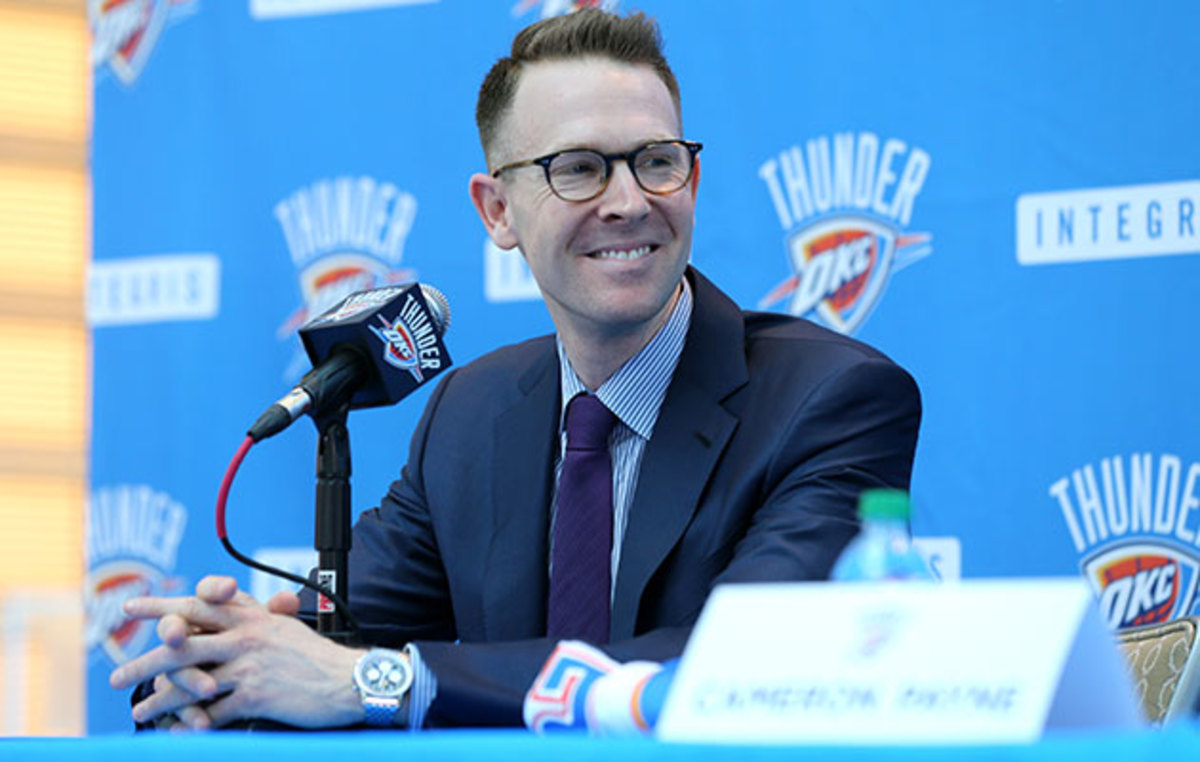
Sam Presti’s eyes widen behind small, thin-rimmed spectacles. “Self One and Self Two! I love that book!”
This is last week, before Game 2 of the Western Conference finals, in the tunnel outside the visiting locker room at Oracle Arena. In the weeks after my first conversation with Kerr, I’d gone in search of other NBA devotees, curious if the Warriors were all reading tennis tips at night. I received a fair amount of blank stares. GM Bob Myers knew of it but hadn’t read it. Same went for assistant GM Kirk Lacob, who says he rarely reads books anymore (but did, he noted, finish the equivalent of 90 book’s worth of online stories on the Pocket app last year, putting him in the top 1% of users). Harrison Barnes said Kerr recommended “Inner Game” to him and that it was on his reading list for the playoffs (last year, on Kerr’s recommendation Barnes read “The Mindful Athlete”, by George Mumford, a counselor to Phil Jackson). Jud Buechler, Kerr’s old teammate with the Bulls, hadn’t read the book but recalled, “That was Steve’s book. He always had it with him.” Warriors assistant Bruce Fraser, Kerr’s best friend, read it a while back but didn’t have the same connection as Kerr. “Steve is cerebral and he’s an overthinker,” Fraser explained. “I think the Inner Game of Tennis speaks to that type of person. The one that almost gets in their own way. That’s not me so much.” (Engelland agrees: “It’s not for every personality.”)
When I read the book, some of it struck me as vague. Other suggestions felt impractical. How would I just “let” my body take over in tennis if it wasn’t already proficient? Still, much of it caused me to pause and reflect. Like Kerr, I underlined passages and scribbled notes in the margins. In particular, a late discussion about the value of competition struck a chord. Never feel bad about playing hard against someone, Gallwey writes, because the true value of competition is not in satisfying the ego (for its needs are bottomless), or trying to reach perfection (unattainable) but in trying to reach one’s potential in any given moment, for that is the ultimate reward. And, in putting forth your best effort in a match or games, you are directly helping your opponent reach his. It’s the ultimate process over outcome argument. (For what it’s worth, I also tried out the strategies, endeavoring to quiet my mind in rec league hoops games, coach my daughter’s soccer team using demonstration, and live in the moment. To an extent, it worked. I did feel calmer. I enjoyed the moments more. In the end, it reminded me of the line in the movie Bridge of Spies, when Tom Hanks’ character asks a Russian spy “Aren’t you worried?” The spy responds: “Would it help?”)
And now here was Presti, the Thunder's GM, another believer. His enthusiasm was contagious. “I’m always re-reading it,” he said, becoming excited. “It’s a tremendous tool for experiencing life as it comes to you, not looking ahead or behind. We miss what’s right in front of us.” Like Kerr, Presti received the book from Engelland, when he was in San Antonio, and he reads it so often that he’s created a Word document with favorite passages—his own Cliffs Notes. Presti also gave the book to his staff to read, as well as Thunder reserve Nick Collison (though he doesn’t think Collison has read it).
Presti said he distinctly recalls the first time he saw the "Inner Game" in action, in 2003, when he was a recently-promoted assistant director of scouting with the Spurs. It was Game 6 of the Western Conference finals between San Antonio and Dallas. Down 15 in the third quarter and desperate, Spurs coach Gregg Popovich turned to a seldom-used, 37-year-old who’d played only three minutes in the series to date. The veteran came in and calmly hit his first three-pointer—his first trifecta in over a month.
Watching, Presti had an immediate reaction. As he says: “I remember thinking, ‘That’s the book! That’s the 'Inner Game!’”
In the minutes that followed, the veteran hit another three, and another, eventually finishing 4-of-4 from behind the arc to lift San Antonio to a series-clinching victory, in what would be the final defining moment of his playing career.
That veteran, of course, was Kerr.
